Alcázar of Seville
| Cathedral, Alcázar and General Archive of the Indies in Seville | |
|---|---|
| Name as inscribed on the World Heritage List | |
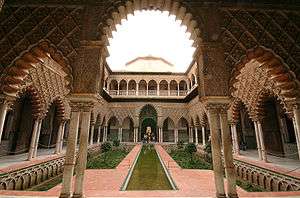 The Courtyard of the Maidens | |
| Type | Cultural |
| Criteria | i, ii, iii, vi |
| Reference | 383 |
| UNESCO region | Europe and North America |
| Inscription history | |
| Inscription | 1987 (11th Session) |
The Alcázar of Seville (Spanish "Reales Alcázares de Sevilla" or "Royal Alcazars of Seville", (Spanish pronunciation: [alˈkaθar])) is a royal palace in Seville, Spain, originally developed by Moorish Muslim kings. The palace is renowned as one of the most beautiful in Spain, being regarded as one of the most outstanding examples of mudéjar architecture found on the Iberian Peninsula.[1] The upper levels of the Alcázar are still used by the royal family as the official Seville residence and are administered by the Patrimonio Nacional. It is the oldest royal palace still in use in Europe, and was registered in 1987 by UNESCO as a World Heritage Site, along with the Seville Cathedral and the General Archive of the Indies.[2]
Etymology
The term ‘Alcázar’ comes from the Hispano-Arabic word ‘Alqáşr’ meaning ‘Royal House’ or ‘Room of the Prince’ (whether fortified or not).[3]
History
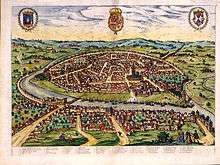
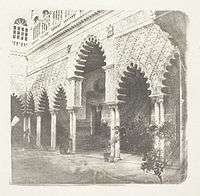
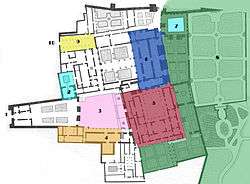
- 1-Puerta del León
- 2-Sala de la Justicia y patio del Yeso (cyan)
- 3-Patio de la Montería (pink)
- 4-Cuarto del Almirante y Casa de Contratación (cream)
- 5-Palacio mudéjar o de Pedro I (red)
- 6-Palacio gótico (blue)
- 7-Estanque de Mercurio
- 8-Jardines (green)
- 9-Apeadero
- 10-Patio de Banderas
The Real Alcázar is situated near the Cathedral and the General Archive of the Indies in one of Spain's most emblematic areas.[3]
The Almohades were the first to build a palace, which was called Al-Muwarak, on the site of the modern day Alcázar. It is one of the most representative monumental compounds in the city, the country and the Mediterranean culture. Its influences held within its walls and gardens began in the Arabic period and continued into the late Middle Ages Mudéjar period right through to the Renaissance, the Baroque era, and the 19th century.[4] Subsequent monarchs have made their own additions to the Alcázar.
The palace was the birthplace of Infanta Maria Antonietta of Spain (1729-1785), daughter of Philip V of Spain and Elisabeth Farnese. The king was in the city to oversee the signing of the Treaty of Seville (1729) which ended the Anglo-Spanish War (1727).
The Palace

Puerta del León
The main entrance to the Alcázar takes its name from the 19th century tile-work inlaid above it, a crowned lion holding a cross in its claws and bearing a Gothic script.[5]
Patio de las Doncellas

The name, meaning "The Courtyard of the Maidens", refers to the legend that the Moors demanded 100 virgins every year as tribute from Christian kingdoms in Iberia.
The lower level of the Patio was built for King Peter I and includes inscriptions describing Peter as a "sultan". Various lavish reception rooms are located on the sides of the Patio. In the center is a large, rectangular reflecting pool with sunken gardens on either side. For many years, the courtyard was entirely paved in marble with a fountain in the center. However, historical evidence showed the gardens and the reflecting pool were the original design and this arrangement was restored. However, soon after this restoration, the courtyard was temporarily paved with marble once again at the request of movie director Ridley Scott. Scott used the paved courtyard as the set for the court of the King of Jerusalem in his movie Kingdom of Heaven. The courtyard arrangement was converted once more after the movie's production.
The upper story of the Patio was an addition made by Charles V. The addition was designed by Luis de Vega in the style of the Italian Renaissance although he did include both Renaissance and mudéjar plaster work in the decorations. Construction of the addition began in 1540 and ended in 1572.
Los Baños de Doña María de Padilla
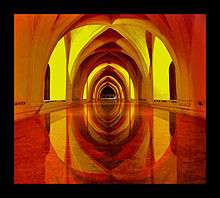
The "Baths of Lady María de Padilla" are rainwater tanks beneath the Patio del Crucero. The tanks are named after María de Padilla, the mistress of Peter the Cruel.
La Casa de Contratación
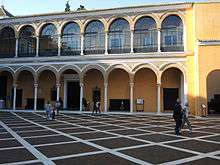
The Casa de Contratación (House of Trade) was established in 1503 by the Catholic Monarchs to regulate trade with the New World colonies after the discovery of America. The Casa controlled the governmental apparatus of Spanish exploration and colonization, and consequently dealt with legal disputes concerning trade with the Americas. Its administration buildings were located near the Patio de la Monteria and included the chapel where Columbus met with Ferdinand and Isabella after his second voyage. The chapel today houses paintings of some of the most celebrated voyages of the discoverers, such as The Virgin of the Navigators, one of the first paintings to depict the discovery of the Americas and one of the earliest paintings to depict Columbus, and Magellan's first voyage around the World.
To accommodate that institution, the city of Seville was chosen. That same year, construction and arrangement of the necessary buildings was ordered. What survives today of the old House of Trade is only part of the original construction, which included a number of buildings that stretched from the current Patio de la Monteria to Plaza de la Contratación, where it had its main façade. This area included, among others, the Admiral's room or Chapter House, with two two-story buildings, a chapel, another area of warehouses and rooms around a courtyard, next to the Plaza de la Contratación, this part being demolished in 1964. In 1717, the agency moved to the city of Cádiz. Since 1793, when the Casa de Contratación was shut down, all its former departments were merged into the Alcázar .
Other sections
- Patio de las Muñecas
- Patio de la Monteria
- Dormitorio de los Reyes Moros
- Salón de Embajadores, 1427
Detail Gallery
The Gardens
All the palaces of Al Andalus had garden orchards with fruit trees, horticultural produce and a wide variety of fragrant flowers. The garden-orchards not only supplied food for the palace residents but had the aesthetic function of bringing pleasure. Water was ever present in the form of irrigation channels, runnels, jets, ponds and pools.
The gardens adjoining the Alcázar of Seville have undergone many changes. In the 16th century during the reign of Philip III the Italian designer Vermondo Resta introduced the Italian Mannerist style. Resta was responsible for the Galeria de Grutesco (Grotto Gallery) transforming the old Muslim wall into a loggia from which to admire the view of the palace gardens.[6]
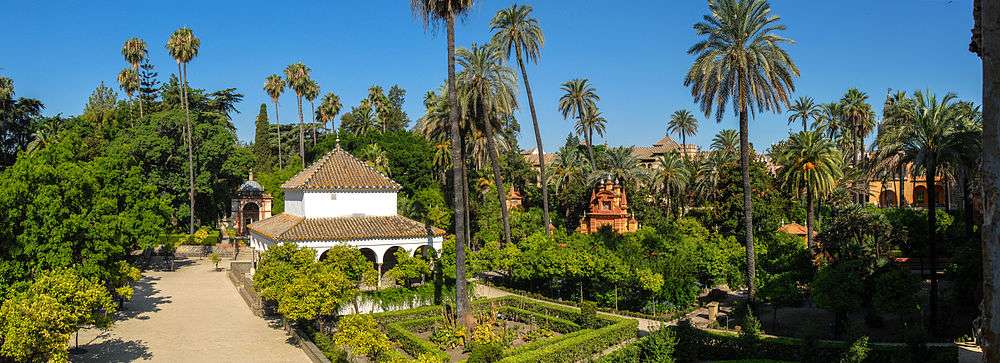
Mercury Pond
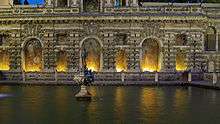
Taking the form of a large pond, located at the highpoint of the palace and thus higher than the rest of the gardens, the reservoir is presided over by the figure of the god Mercury, designed by Diego de Pesquera and cast by Bartolomé Morel in 1576. These men also contributed railings with shields with lions at their corners and 18 balls with pyramidal finials surrounding the pond. All these elements were originally gilded, but only traces remain of the coating. The backdrop is the "Gallery of the Grotesque," which was constructed on an old Almohad wall. Further contributions and a change decoration were made by Vermondo Resta around 1612, making this the most Mannerist section of the Alcázar. It consists of rustically worked stones of different types that simulate marine rocks. These stone elements form quadrangular spaces, and at the halfway point the walls are painted red to mimic red marble. The walls also show mythological figures and exotic birds, painted by Diego de Esquivel in the seventeenth century. The top of gallery is decorated with spires in the form of castle crenelation. In the front of the pond, there is a fountain with a recently restored water organ from the seventeenth century.[7]
In popular culture
- In 1962 the Alcázar was used as a set for Lawrence of Arabia.[8]
- The Patio de las Doncellas was used as the set for the court of the King of Jerusalem in the 2005 movie Kingdom of Heaven.
- Part of the fifth season of Game of Thrones was shot in several locations in the province of Seville, including the Alcázar.
See also
References
- ↑ The Real Alcázar of Seville, Editorial Palacios y Museos, José Barea, 2014, p.47, ISBN 978-84-8003-637-5
- ↑ "Cathedral, Alcázar and Archivo de Indias in Seville". UNESCO. Retrieved 2009-06-01.
- 1 2 The Real Alcázar of Seville, Editorial Palacios y Museos, José Barea, 2014, p.5, ISBN 978-84-8003-637-5
- ↑ "Royal Alcázar of Seville".
- ↑ The Real Alcázar of Seville, Editorial Palacios y Museos, José Barea, 2014, p.10, ISBN 978-84-8003-637-5
- ↑ The Real Alcázar of Seville, Editorial Palacios y Museos, José Barea, 2014, p.121, ISBN 978-84-8003-637-5
- ↑ "Apuntes del Alcázar".
- ↑ El día que Lawrence de Arabia cambió el desierto por Sevilla. Diario el Mundo
External links
| Wikimedia Commons has media related to Alcázar of Seville. |
- InFocus: Alcázar of Seville (Sevilla, Spain) at HitchHikers Handbook
- Images of the Alcázar in Seville - 105 images with good descriptions of the Alcázar and its history.
- Casa de la Contratación - in depth historical article.
- El Real Alcázar de Sevilla (In Spanish, English and French)
- UNESCO World Heritage
Coordinates: 37°23′02″N 5°59′29″W / 37.38389°N 5.99139°W

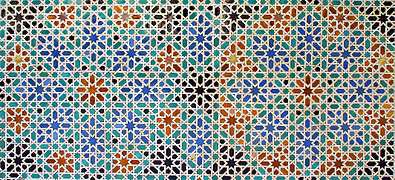
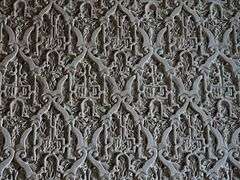

.jpg)
